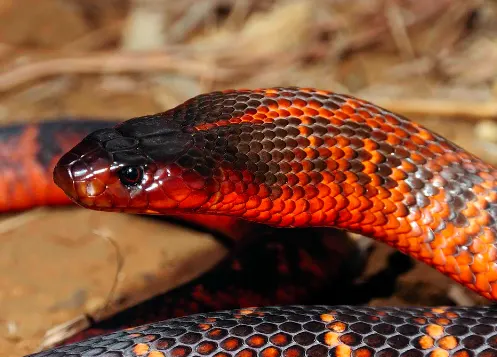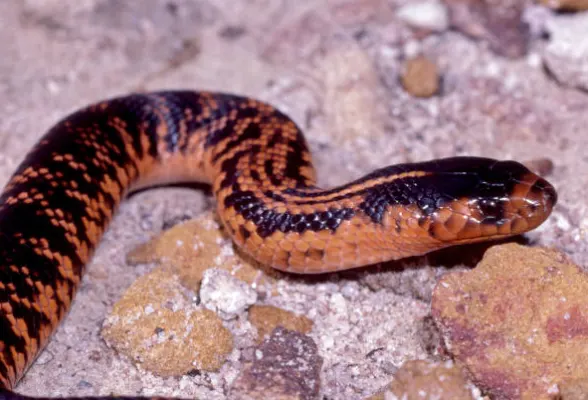Collett’s Snake, scientifically known as Pseudechis colletti, is a remarkable species of the Elapidae family. Native to Queensland, Australia, this snake is known for its striking appearance and potent venom. Despite its beauty, Collett’s Snake is one of the most venomous snakes in the world, ranking 19th globally. This blog delves into the fascinating aspects of Collett’s Snake, covering its habitat, behavior, physical characteristics, and more.

Table of Contents
Habitat and Distribution
Collett’s Snake is primarily found in central-western Queensland, Australia. The species thrives in dry and barren regions, including plains, shrublands, and low woodlands. While they are mostly terrestrial, these snakes are sometimes found in trees, seeking shelter in abandoned nests. Their habitat preference for subtropical climates makes them well-suited to the arid regions of Australia.
Being diurnal, Collett’s Snakes are most active during the day, making daylight the best time to observe them in their natural habitat. However, due to their venomous nature, it’s advisable to maintain a safe distance.
Physical Characteristics
Collett’s Snake is easily identifiable by its distinctive coloration. The upper body is typically dark brown to black, adorned with vibrant bands of pink or red that run along the length of the snake’s body. These bands create a striking contrast against the darker background, making Collett’s Snake one of the most colorful members of the black snake species.
Adults can grow to lengths between 5.9 and 7.2 feet, with the juveniles measuring just under a foot at birth. The snake’s head is usually darker, with a lighter snout, and its eyes are dark brown, encircled by a reddish-brown rim. The snake’s body is covered in 19 rows of midbody scales, with 215-235 ventral scales.
Diet and Hunting Behavior
Collett’s Snake is carnivorous, with a diet that primarily includes small mammals, reptiles, and amphibians. Interestingly, these snakes are known to exhibit cannibalistic tendencies, occasionally preying on other Collett’s Snakes. In their natural habitat, they often hunt local geckos and other small animals.
These snakes are ambush predators, relying on their venom to incapacitate prey. They use their keen sense of smell and sight to detect and track their prey, striking with precision when the moment is right. Once the venom has taken effect, the snake swallows its prey whole.
Reproduction and Lifespan
The reproductive season for Collett’s Snakes typically begins between August and October. During this period, males engage in a courtship ritual where they crawl over the female’s back. Copulation can last up to six hours. After fertilization, the female lays a clutch of up to 20 eggs, which take about 91 days to hatch.
Newly hatched Collett’s Snakes may remain in their eggs for an additional 12 hours before emerging. These juveniles closely resemble the adults in terms of coloration, though their colors are more vibrant and contrasting. Collett’s Snakes are relatively easy to breed in captivity, which has led to their popularity among snake breeders.
Venom and Danger to Humans
Collett’s Snake is highly venomous, with a venom that is both cytotoxic and neurotoxic. A single bite from this snake can deliver approximately 30 mg of venom, enough to cause severe symptoms such as nausea, vomiting, abdominal pain, diarrhea, and headaches. If left untreated, the venom can lead to rhabdomyolysis (muscle breakdown), acute kidney injury, and potentially death.
Due to its potent venom, a bite from Collett’s Snake should be treated as a medical emergency. Victims should seek immediate medical attention, as antivenom specific to black snakes is required. In the meantime, applying pressure to the bite area and immobilizing the limb with a bandage can help slow the spread of venom.
Conservation Status
Despite its potent venom, Collett’s Snake is not currently considered to be at risk of extinction. The International Union for Conservation of Nature (IUCN) lists Collett’s Snake as a species of “Least Concern.” However, like all Australian snakes, they are protected by federal law, which prohibits hunting and capturing them in the wild.
In captivity, Collett’s Snake is relatively common, particularly in Victoria, where they are often bred by snake enthusiasts. The snake’s vibrant coloration and unique characteristics make it a popular choice among reptile collectors.

Behavior and Interaction with Humans
Collett’s Snake is known for its shy and reclusive nature. Despite its bright and attractive appearance, this snake prefers to avoid human interaction and will usually retreat if encountered. It is not an aggressive species and will only bite if threatened or provoked.
Due to their venomous nature, Collett’s Snakes are not recommended as pets for inexperienced handlers. However, they are sometimes kept in captivity by experienced reptile enthusiasts who appreciate their beauty and unique characteristics.
Collett’s Snake is a fascinating species that combines beauty with danger. Its striking coloration, potent venom, and shy demeanor make it a unique and intriguing reptile. While it is not a snake that one would want to encounter in the wild, it is undoubtedly a remarkable species worthy of study and appreciation. Whether you are a snake enthusiast or simply curious about wildlife, Collett’s Snake offers a captivating glimpse into the diverse and sometimes dangerous world of reptiles.
- Enchi Ball Python: A Unique and Stunning Morph of Python regius - March 27, 2025
- Emerald Tree Monitor: The Enigmatic Green Guardian of the Rainforest - March 26, 2025
- The Egyptian Cobra (Naja haje): A Fascinating Serpent - March 25, 2025
